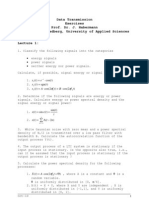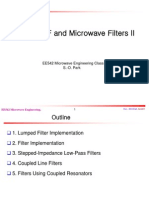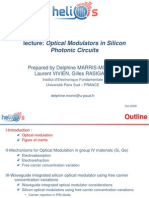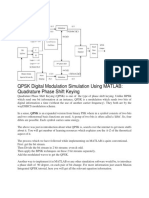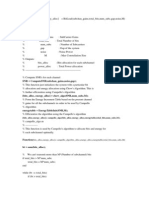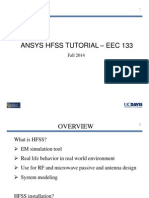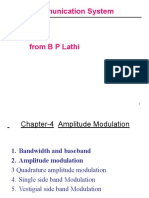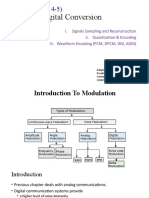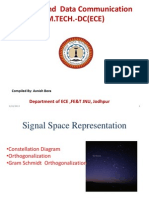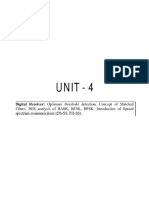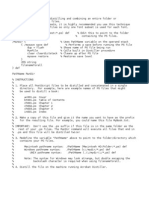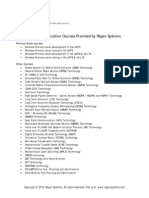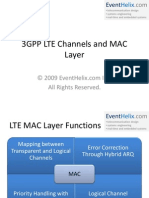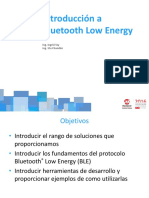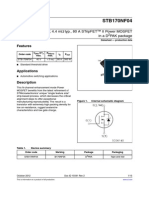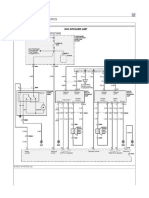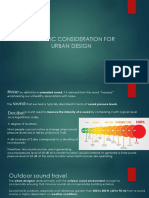DIGITAL MODULATIONS (Chapter 8)
Why digital modulation?
q
If our goal was to design a digital baseband communication system, we have done that Problem is baseband communication wont takes us far, literally and figuratively Digital modulation to a square pulse is what analog modulation was to messages
1999 BG Mobasseri
�A block diagram
Messsage source
Source coder
1011 Line coder
Pulse shaping
modulator
channel
decision
detector
demodulator
1999 BG Mobasseri
�GEOMETRIC REPRESENTATION OF SIGNALS
�The idea
q
We are used to seeing signals expressed either in time or frequency domain There is another representation space that portrays signals in more intuitive format In this section we develop the idea of signals as multidimensional vectors
1999 BG Mobasseri
�Have we seen this before?
q
Why yes! Remember the beloved ej2fct which can be written as ej2fct=cos(2fct)+jsin(2fct)
quadrature
inphase
1999 BG Mobasseri
�Expressing signals as a weighted sum
q
Suppose a signal set consists of M signals si(t),I=1,,M. Each signal can be represented by a linear sum of basis functions
1999 BG Mobasseri
�Conditions on basis functions
q
For the expansion to hold, basis functions must be orthonormal to each other Mathematically: Geometrically:
1999 BG Mobasseri
�Components of the signal vector
q
Each signal needs N numbers to be represented by a vector. These N numbers are given by projecting each signal onto the individual basis functions:
si
sij means projection of si (t)on j(t)
sij
1999 BG Mobasseri
�Signal space dimension
q
How many basis functions does it take to express a signal? It depends on the dimensionality of the signal Some need just 1 some need an infinite number. The number of dimensions is N and is always less than the number of signals in the set N<=M
1999 BG Mobasseri
10
�Example: Fourier series
q
Remember Fouirer series? A signal was expanded as a linear sum of sines and cosines of different frequencies. Sounds familiar? Sines and cosines are the basis functions and are in fact orthogonal to each other
1999 BG Mobasseri
11
�Example: four signal set
q
A communication system sends one of 4 possible signals. Expand each signal in terms of two given basis functions
1 2 1
-0.5 1 1
1999 BG Mobasseri
12
�Components of s1(t)
q
This is a 2-Dsignal space. Therefore, each signal can be represented by a pair of numbers. Lets find them For s1(t) s (t)
1
1 t -0.5 1
1
s=(1,-0.5)
1 1999 BG Mobasseri 2
t 13
�Interpretation
q
s1(t) is now condensed into just two numbers. We can reconstruct s1(t) like this s1(t)=(1) 1(t)+(-0.5) 2(t) Another way of looking at it is this 2
1 -0.5
1999 BG Mobasseri
14
�Signal constellation
q
Finding individual components of each signal along the two dimensions gets us the constellation 2 s4
s2
-0.5 -0.5
0.5 s1
s3
1999 BG Mobasseri
15
�Learning from the constellation
q
So many signal properties can be inferred by simple visual inspection or simple math Orthogonality:
s1 and s4 or orthogonal. To show that, simply find their inner product, < s1, s4>
< s1, s4>=s11xs41+s12xs42(1)(0.5)+(1)(-0.5)=0
1999 BG Mobasseri
16
�Finding the energy from the constellation
q
This is a simple matter. Remember,
Replace the signal by its expansion
1999 BG Mobasseri
17
�Exploiting the orthogonality of basis functions
q
Expanding the summation, all cross product terms integrate to zero. What remains are N terms where j=k
1999 BG Mobasseri
18
�Energy in simple language
q
What we just saw says that the energy of a signal is simply the square of the length of its corresponding constellation vector
2
E=9+4=13
3
1999 BG Mobasseri
19
�Constrained energy signals
q
Lets say you are under peak energy Ep constraint in your application. Just make sure all your signals are inside a circle of radius sqrt(Ep )
1999 BG Mobasseri
20
�Correlation of two signals
q
A very desirable situation in is to have signals that are mutually orthogonal. How do we test this? Find the angle between them
transpose s1 s2
1999 BG Mobasseri
21
�Find the angle between s1 and s2
q
Given that s1=(1,2)T and s2=(2,1)T, what is the angle between the two?
1999 BG Mobasseri
22
�Distance between two signals
q
The closer signals are together the more chances of detection error. Here is how we can find their separation
2
1 1 2
1999 BG Mobasseri
23
�Constellation building using correlator banks
q
We can decompose the signal into its components as follows
s1
1
s2 s(t)
2
N components
sN
N
1999 BG Mobasseri
24
�Detection in the constellation space
q
Received signal is put through the filter bank below and mapped to a point
s1
1
s2 s(t)
2
components mapped to a single point sN
1999 BG Mobasseri
25
�Constellation recovery in noise
q
Assume signal is contaminated with noise. All N components will also be affected. The original position of si(t) will be disturbed
1999 BG Mobasseri
26
�Actual example
q
Here is a 16-level constellation which is reconstructed in the presence of noise
Eb/No=5 dB
2
1.5
0.5
-0.5
-1
-1.5
-2 -2 -1.5 -1 -0.5 0 0.5 1 1.5 2
1999 BG Mobasseri
27
�Detection in signal space
q
One of the M allowable signals is transmitted, processed through the bank of correlators and mapped onto constellation question is based on what we see , what was the transmitted signal?
received signal which of the four did it come from
1999 BG Mobasseri
28
�Minimum distance decision rule
q
It can be shown that the optimum decision, in the sense of lowest BER, is to pick the signal that is closest to the received vector. This is called maximum likelihood decision making
this is the most likely transmitted signal
received
1999 BG Mobasseri
29
�Defining decision regions
q
An easy detection method, is to compute decision regions offline. Here are a few examples
decide s2 decide s1 measurement s2 s1 s3 decide s3 s4 decide s4 30 s2 decide s1 s1 decide s1
s1
decide s2
1999 BG Mobasseri
�More formally...
q
Partition the decision space into M decision regions Zi, i=1,,M. Let X be the measurement vector extracted from the received signal. Then if XZi si was transmitted
1999 BG Mobasseri
31
�How does detection error occur?
q
Detection error occurs when X lands in Zi but it wasnt si that was transmitted. Noise, among others, may be the culprit
X si
departure from transmitted position due to noise
1999 BG Mobasseri
32
�Error probability
q
we can write an expression for error like this P{error|si}=P{X does not lie in Zi|si was transmitted} Generally
1999 BG Mobasseri
33
�Example: BPSK (binary phase shift keying)
q
BPSK is a well known digital modulation obtained by carrier modulating a polar NRZ signal. The rule is 1: s1=Acos(2fct) 0:s2= - Acos(2fct)
1s and 0s are identified by 180 degree phase reversal at bit transitions
1999 BG Mobasseri
34
�Signal space for BPSK
q
Look at s1 and s2. What is the basis function for them? Both signals can be uniquely written as a scalar multiple of a cosine. So a single cosine is the sole basis function. We have a 1-D constellation
cos(2pifct) -A A
1999 BG Mobasseri
35
�Bringing in Eb
q
We want each bit to have an energy Eb. Bits in BPSK are RF pulses of amplitude A and duration Tb. Their energy is A2Tb/2 . Therefore Eb= A2Tb/2 --->A=sqrt(2Eb/Tb) We can write the two bits as follows
1999 BG Mobasseri
36
�BPSK basis function
q
As a 1-D signal, there is one basis function. We also know that basis functions must have unit energy. Using a normalization factor
E =1
1999 BG Mobasseri
37
�Formulating BER
q
BPSK constellation looks like this
received X|1=[Eb+n,n] if noise is negative enough, it will push X to the left of the boundary, deciding 0 instead
-Eb
noise
noise
Eb
transmitted
1999 BG Mobasseri
38
�Finding BER
q
Lets rewrite BER
But n is gaussian with mean 0 and variance No/2
-sqrt(Eb) 1999 BG Mobasseri 39
�BER for BPSK
q
Using the trick to find the area under a gaussian density(after normalization with respect to variance) BER=Q[(2Eb/No)0.5] or BER=0.5erfc[(Eb/No)0.5]
1999 BG Mobasseri
40
�BPSK Example
q
Data is transmitted at Rb=106 b/s. Noise PSD is 10-6 and pulses are rectangular with amplitude 0.2 volt. What is the BER? First we need energy per bit, Eb. 1s and 0s are sent by
1999 BG Mobasseri
41
�Solving for Eb
q
Since bit rate is 106, bit length must be 1/Rb=10-6 Therefore, Eb=20x10-6=20 w-sec Remember, this is the received energy. What was transmitted are probably several orders of magnitude bigger
1999 BG Mobasseri
42
�Solving for BER
q
Noise PSD is No/2 =10-6. We know for BPSK BER=0.5erfc[(Eb/No)0.5] What we have is then
Finish this using erf tables
1999 BG Mobasseri
43
�Binary FSK (Frequency Shift Keying)
q
Another method to transmit 1s and 0s is to use two distinct tones, f1 and f2 of the form below
But what is the requirements on the tones? Can they be any tones?
1999 BG Mobasseri
44
�Picking the right tones
q q
It is desirable to keep the tones orthogonal Since tones are sinusoids, it is sufficient for the tones to be separated by an integer multiple of inverse duration, i.e.
1999 BG Mobasseri
45
�Example tones
q
Lets say we are sending data at the rate of 1 Mb/sec in BFSK, What are some typical tones? Bit length is 10-6 sec. Therefore, possible tones are (use nc=0) f1=1/Tb=1 MHz f2=2/Tb=2MHz
1999 BG Mobasseri
46
�BFSK dimensionality
q
What does the constellation of BFSK look like? We first have to find its dimension s1 and s2 can be represented by two orthonormal basis functions:
Notice f1 and f2 are selected to make them orthogonal
1999 BG Mobasseri
47
�BFKS constellation
q
There are two dimensions. Find the components of signals along each dimension using
1999 BG Mobasseri
48
�Decision regions in BFSK
q
45 d
eg
re el in e
Decisions are made based on distances. Signals closer to s1 will be classified as s1 and vice versa
1999 BG Mobasseri
49
�Detection error in BFSK
q q
Let the received signal land where shown. Assume s1 is sent. How would a detection error occur?
s2
x2>x1 puts X in the
Pe1=P{x2>x1|s1 was sent}
x2 s1 x1
X=received
s2 partition
1999 BG Mobasseri
50
�Where do (x1,x2) come from?
q
Use the correlator bank to extract signal components
x1(gaussian) x= s1(t)+noise
1
x2(gaussian)
1999 BG Mobasseri
51
�Finding BER
q
We have to answer this question: what is the probability of one random variable exceeding another random variable? To cast P(x2>x1) into like of P(x>2), rewrite P(x2>x1|x1) x1 is now treated as constant. Then, integrate out x1 to eliminate it
1999 BG Mobasseri
52
�BER for BFSK
q
Skipping the details of derivation, we get
1999 BG Mobasseri
53
�BPSK and BFSK comparison: energy efficiency
q
Lets compare their BERs
What does it take to have the same BER? Eb in BFSK must be twice as big as BPSK Conclusion: energy per bit must be twice as large in BFSK to achieve the same BER
1999 BG Mobasseri
54
�Comparison in the constellation space
q
Distances determine BERs. Lets compare
Both have the same Eb, but BPSKs are farther apart, hence lower BER
1999 BG Mobasseri
55
�Differential PSK
q
q q
Concept of differential encoding is very powerful Take the the bit sequence 11001001 Differentially encoding of this stream means that we start we a reference bit and then record changes
1999 BG Mobasseri
56
�Differential encoding example
q
Data to be encoded 1 0 0 1 0 0 1 1 Set the reference bit to 1, then use the following rule
Generate a 1 if no change Generate a 0 if change
1 0 0 1 0 0 1 1 1 1 0 1 1 0 1 1 1
1999 BG Mobasseri
57
�Detection logic
q
Detecting a differentially encoded signal is based on the comparison of two adjacent bits If two coded bits are the same, that means data bit must have been a 1, otherwise 0 ? ? ? ? ? ? ? ? 1 0 1 1 0 1 1 1
unknown transmitted bits Encoded received bits
58
1999 BG Mobasseri
�DPSK: generation
q
Once data is differentially encoded, carrier modulation can be carried out by a straight BPSK encoding
Digit 1:phase 0 Digit 0:phase 180
1 1 0 1 1 0 1 1 1 0 0 0 0 0 0 0
Differentially encoded data Phase encoded(BPSK)
1999 BG Mobasseri
59
�DPSK detection
q
Data is detected by a phase comparison of two adjacent pulses
No phase change: data bit is 1 Phase change: data bit is 0
0 0 0 0
Detected data 1 0 0 1 0
0 0 0
0 1 1
1999 BG Mobasseri
60
�Bit errors in DPSK
q q
Bit errors happen in an interesting way Since detection is done by comparing adjacent bits, errors have the potential of propagating Allow a single detection error in DPSK 0 0 0 0 0 0
Incoming phases
Detected bits Transmitted bits
1 1
0 0
1 0
0 1
0 0
0 0
1 1
1 1
61
2 errors
Back on track:no errors
1999 BG Mobasseri
�Conclusion
q
In DPSK, if the phase of the RF pulse is detected in error, error propagates However, error propagation stops quickly. Only two bit errors are misdetected. The rest are correctly recovered
1999 BG Mobasseri
62
�Why DPSK?
q
Detecting regular BPSK needs a coherent detector, requiring a phase reference DPSK needs no such thing. The only reference is the previous bit which is readily available
1999 BG Mobasseri
63
�M-ary signaling
q
Binary communications sends one of only 2 levels; 0 or 1 There is another way: combine several bits into symbols 1 0 1 1 0 1 1 0 1 1 1 0 0 1 1 Combining two bits at a time gives rise to 4 symbols; a 4-ary signaling
1999 BG Mobasseri
64
�8-level PAM
q
Here is an example of 8-level signaling
binary 0 1 7 5 3 2 1 -1 -3 -5 -7
1999 BG Mobasseri 65
1 0 0 0
0 0 0 0
1 1
1 0 1 0
0 1 1
�A few definitions
q
We used to work with bit length Tb. Now we have a new parameter which we call symbol length,T
1 Tb 0 1
1999 BG Mobasseri
66
�Bit length-symbol length relationship
q
When we combine n bits into one symbol; the following relationships hold T=nTb- symbol length n=logM bits/symbol T=TbxlogM- symbol length
All logarithms are base 2
1999 BG Mobasseri
67
�Example
q
If 8 bits are combined into one symbol, the resulting symbol is 8 times wider Using n=8, we have M=28=256 symbols to pick from Symbol length T=nTb=8Tb
1999 BG Mobasseri
68
�Defining baud
q
When we combine n bits into one symbol, numerical data rate goes down by a factor of n We define baud as the number of symbols/sec Symbol rate is a fraction of bit rate R=symbol rate=Rb/n=Rb/logM For 8-level signaling, baud rate is 1/3 of bit rate
1999 BG Mobasseri 69
�Why M-ary?
q
Remember Nyquist bandwidth? It takes a minimum of R/2 Hz to transmit R pulses/sec. If we can reduce the pulse rate, required bandwidth goes down too M-ary does just that. It takes Rb bits/sec and turns it into Rb/logM pulses sec.
1999 BG Mobasseri
70
�Issues in transmitting 9600 bits/sec
q
Want to transmit 9600 bits/sec. Options:
Nyquists minimum bandwidth:9600/2=4800 Hz Full roll off raised cosine:9600 Hz
None of them fit inside the 4 KHz wide phone lines Go to a 16 - level signaling, M=16. Pulse rate is reduced to R=Rb/logM=9600/4=2400 Hz
1999 BG Mobasseri
71
�Using 16-level signaling
q
Go to a 16-level signaling, M=16. Pulse rate is then cut down to R=Rb/logM=9600/4=2400 pulses/sec To accommodate 2400 pulses /sec, we have several options. Using sinc we need only 1200 Hz. Full roll-off needs 2400Hz Both fit within the 4 KHz phone line bandwidth
1999 BG Mobasseri
72
�Bandwidth efficiency
q
Bandwidth efficiency is defined as the number of bits that can be transmitted within 1 Hz of bandwidth =Rb/BT bits/sec/Hz In binary communication using sincs, BT=Rb/2--> =2 bits/sec/Hz
1999 BG Mobasseri
73
�M-ary bandwidth efficiency
q
In M-ary signaling , pulse rate is given by R=Rb/logM. Full roll-off raised cosine bandwidth is BT=R= Rb/logM. Bandwidth efficiency is then given by =Rb/BT=logM bits/sec/Hz For M=2, binary we have 1 bit/sec/Hz. For M=16, we have 4 bits/sec/Hz
1999 BG Mobasseri
74
�M-ary bandwidth
q
Summarizing, M-ary and binary bandwidth are related by BM-ary=Bbinary/logM
Clearly , M-ary bandwidth is reduced by a factor of logM compared to the binary bandwidth
1999 BG Mobasseri
75
�8-ary bandwidth
q
Let the bit rate be 9600 bits/sec. Binary bandwidth is nominally equal to the bit rate, 9600 Hz We then go to 8-level modulation (3 bits/symbol) M-ary bandwidth is given by BM-ary=Bbinary/logM=9600/log8=3200 Hz
1999 BG Mobasseri
76
�Bandwidth efficiency numbers
q
Here are some numbers n(bits/symbol) M(levels) 1 2 2 4 3 8 4 16 8 256
(bits/sec/Hz) 1 2 3 4 8
1999 BG Mobasseri
77
�Symbol energy vs. bit energy
q
Each symbol is made up of n bits. It is not therefore surprising for a symbol to have n times the energy of a bit E(symbol)=nEb Eb
E
1999 BG Mobasseri
78
�QPSK quadrature phase shift keying
q q
This is a 4 level modulation. Every two bits is combined and mapped to one of 4 phases of an RF signal These phases are 45o,135o,225o,315o
Symbol energy
Symbol width
1999 BG Mobasseri 79
�QPSK constellation
01
00 45o E 10
11
Basis functions
S=[0.7 E,- 0.7 E]
1999 BG Mobasseri
80
�QPSK decision regions
01
00
11
10
Decision regions re color-coded
1999 BG Mobasseri
81
�QPSK error rate
q
Symbol error rate for QPSK is given by
This brings up the distinction between symbol error and bit error. They are not the same!
1999 BG Mobasseri
82
�Symbol error
q
Symbol error occurs when received vector is assigned to the wrong partition in the constellation
s2 s1 11 00
When s1 is mistaken for s2, 00 is mistaken for 11
1999 BG Mobasseri 83
�Symbol error vs. bit error
q
When a symbol error occurs, we might suffer more than one bit error such as mistaking 00 for 11. It is however unlikely to have more than one bit error when a symbol error occurs
00 00 10 11 10 10 11 11 10 symbols = 20 bits
1999 BG Mobasseri 84
10 10
Sym.error=1/10 Bit error=1/20
�Interpreting symbol error
q
Numerically, symbol error is larger than bit error but in fact they are describing the same situation; 1 error in 20 bits In general, if Pe is symbol error
1999 BG Mobasseri
85
�Symbol error and bit error for QPSK
q
We saw that symbol error for QPSK was
Assuming no more than 1 bit error for each symbol error, BER is half of symbol error
Remember symbol energy E=2Eb
1999 BG Mobasseri
86
�QPSK vs. BPSK
Lets compare the two based on BER and bandwidth BER Bandwidth BPSK QPSK BPSK QPSK
q
Rb
Rb/2
EQUAL
1999 BG Mobasseri
87
�M-phase PSK (MPSK)
q
If you combine 3 bits into one symbol, we have to realize 23=8 states. We can accomplish this with a single RF pulse taking 8 different phases 45o apart
1999 BG Mobasseri
88
�8-PSK constellation
q
Distribute 8 phasors uniformly around a circle of radius E
45o
Decision region
89
1999 BG Mobasseri
�Symbol error for MPSK
q
We can have M phases around the circle separated by 2/M radians. It can be shown that symbol error probability is approximately given by
1999 BG Mobasseri
90
�Quadrature Amplitude Modulation (QAM)
q
MPSK was a phase modulation scheme. All amplitudes are the same QAM is described by a constellation consisting of combination of phase and amplitudes The rule governing bits-to-symbols are the same, i.e. n bits are mapped to M=2n symbols
1999 BG Mobasseri
91
�16-QAM constellation using Gray coding
16-QAM has the following constellation q Note gray coding 0000 0001 0011 where adjacent symbols differ by only 1 bit 1000 1001 1011
q
0010
1010
1100
1101
1111
1110
0100
0101
0111
0110
1999 BG Mobasseri
92
�Vector representation of 16-QAM
q
There are 16 vectors, each defined by a pair of coordinates. The following 4x4 matrix describes the 16-QAM constellation
1999 BG Mobasseri
93
�What is energy per symbol in QAM?
q
We had no trouble defining energy per symbol E for MPSK. For QAM, there is no single symbol energy. There are many We therefore need to define average symbol energy Eavg
1999 BG Mobasseri
94
�Eavg for 16-QAM
q
Using the [ai,bi] matrix and using E=ai^2+bi^2 we get one energy per signal
Eavg=10
1999 BG Mobasseri 95
�Symbol error for M-ary QAM
q
With the definition of energy in mind, symbol error is approximated by
1999 BG Mobasseri
96
�Familiar constellations
q
Here are a few golden oldies
V.22 600 baud 1200 bps
V.22 bis 600 baud 2400 bps
1999 BG Mobasseri
V.32 bis 2400 baud 9600 bps
97
�M-ary FSK
q
Using M tones, instead of M phases/amplitudes is a fundamentally different way of M-ary modulation The idea is to use M RF pulses. The frequencies chosen must be orthogonal
1999 BG Mobasseri
98
�MFSK constellation: 3-dimensions
q
MFSK is different from MPSK in that each signal sits on an orthogonal axis(basis)
s3 E
s1=[E ,0, 0] s2=[0,E, 0] s3=[0,0,E]
E 1
E s2
2
s1
1999 BG Mobasseri
99
�Orthogonal signals: How many dimensions, how many signals?
q
We just saw that in a 3 dimensional space, we can have no more than 3 orthogonal signals Equivalently, 3 orthogonal signals dont need more than 3 dimensions because each can sit on one dimension Therefore, number of dimensions is always less than or equal to number of signals
1999 BG Mobasseri
100
�How to pick the tones?
q
Orthogonal FSK requires tones that are orthogonal. Two carrier frequencies separated by integer multiples of period are orthogonal
1999 BG Mobasseri
101
�Example
q
Take two tones one at f1 the other at f2. T must cover one or more periods for the integral to be zero
Take f1=1000 and T=1/1000. Then if f2=2000 , the two are orthogonal so will f2=3000,4000 etc
1999 BG Mobasseri 102
�MFSK symbol error
q
Here is the error expression with the usual notations
1999 BG Mobasseri
103
�Spectrum of M-ary signals
q
So far Eb/No, i.e. power, has been our main concern. The flip side of the coin is bandwidth. Frequently the two move in opposite directions Lets first look at binary modulation bandwidth
1999 BG Mobasseri
104
�BPSK bandwidth
q
Remember BPSK was obtained from a polar signal by carrier modulation We know the bandwidth of polar NRZ using square pulses was BT=Rb. It doesnt take much to realize that carrier modulation doubles this bandwidth
1999 BG Mobasseri
105
�Illustrating BPSK bandwidth
The expression for baseband BPSK (polar) bandwidth is SB(f)=2Ebsinc2(Tbf)
q
2/Tb=2Rb
BPSK
1/Tb
BT=2Rb
fc-/Tb
fc
fc+/Tb
1999 BG Mobasseri
106
�BFSK as a sum of two RF streams
q
BFSK can be thought of superposition of two unipolar signals, one at f1 and the other at f2
1
1
BFSK for 1 0 0 1 0 1 1
0.5
0.8
0.6
-0.5
0.4
0.2
-1
1000
2000
3000
4000
5000
6000
7000
8000
-0.2
-0.4
0.5
-0.6
0
-0.8
-1
1000
2000
3000
4000
5000
6000
7000
8000
-0.5
-1
1000
2000
3000
4000
5000
6000
7000
8000
1999 BG Mobasseri
107
�Modeling of BFSK bandwidth
q
Each stream is just a carrier modulated unipolar signal. Each has a sinc spectrum
1/Tb=Rb BT=2 f+2Rb f= (f2-f1)/2
f1
fc fc=(f1+f2)/2
f2
1999 BG Mobasseri
108
�Example: 1200 bps bandwidth
q
The old 1200 bps standard used BFSK modulation using 1200 Hz for mark and 2200 Hz for space. What is the bandwidth? Use BT=2f+2Rb f=(f2-f1)/2=(2200-1200)/2=500 Hz BT=2x500+2x1200=3400 Hz
This is more than BPSK of 2Rb=2400 Hz
1999 BG Mobasseri
109
�Sundes FSK
q
We might have to pick tones f1 and f2 that are not orthogonal. In such a case there will be a finite correlation between the tones
Good points,zero correlation
2(f2-f1)Tb
110
1999 BG Mobasseri
�Picking the 2nd zero crossing: Sundes FSK
q
If we pick the second zc term (the first term puts the tones too close) we get 2(f2-f1)Tb=2--> f=1/2Tb=Rb/2 Sundes FSK bandwidth is then given by BT=2f+2Rb=Rb+2Rb=3Rb The practical bandwidth is a lot smaller
remember f is (f2-f1)/2
q
1999 BG Mobasseri
111
�Sundes FSK bandwidth
q
Due to sidelobe cancellation, practical bandwidth is just BT=2f=Rb
1/Tb=Rb BT=2 f+2Rb f= (f2-f1)/2
f1
fc fc=(f1+f2)/2
f2
1999 BG Mobasseri
112
�BFSK example
q
A BFSK system operates at the 3rd zero crossing of -Tb plane. If the bit rate is 1 Mbps, what is the frequency separation of the tones? The 3rd zc is for 2(f2-f1)Tb=3. Recalling that f=(f2-f1)/2 then f =0.75/Tb Then f =0.75/Tb=0.75x106=750 KHz And BT=2(f +Rb)=2(0.75+1)106=3.5 MHz
q q
1999 BG Mobasseri
113
�Point to remember
q
FSK is not a particularly bandwidth-friendly modulation. In this example, to transmit 1 Mbps, we needed 3.5 MHz. Of course, it is working at the 3rd zero crossing that is responsible Original Sundes FSK requires BT=Rb=1 MHz
1999 BG Mobasseri
114
�Bandwidth of MPSK modulation
�MPSK bandwidth review
q
In MPSK we used pulses that are log2M times wider tan binary hence bandwidth goes down by the same factor. T=symbol width=Tblog2M For example, in a 16-phase modulation, M=16, T=4Tb. Bqpsk=Bbpsk/log2M= Bbpsk/4
1999 BG Mobasseri
116
�MPSK bandwidth
q
MPSK spectrum is given by SB(f)=(2Eblog2M)sinc2(Tbflog2M)
Set to 1 for zero crossing BW Tbflog2M=1 -->f=1/ Tbflog2M =Rb/log2M 1/logM f/Rb
1999 BG Mobasseri
BT= Rb/log2M Notice normalized frequency
117
�Bandwidth after carrier modulation
q
What we just saw is MPSK bandwidth in baseband A true MPSK is carrier modulated. This will only double the bandwidth. Therefore, Bmpsk=2Rb/log2M
1999 BG Mobasseri
118
�QPSK bandwidth
q
QPSK is a special case of MPSK with M=4 phases. Its baseband spectrum is given by SB(f)=2Esinc2(2Tbf)
B=0.5Rb--> half of BPSK 0.5 1 f/Rb
After modulation: Bqpsk=Rb
1999 BG Mobasseri
119
�Some numbers
q q
q q q
Take a 9600 bits/sec data stream Using BPSK: B=2Rb=19,200 Hz (too much for 4KHz analog phone lines) QPSK: B=19200/log24=9600Hz, still high Use 8PSK:B= 19200/log28=6400Hz Use 16PSK:B=19200/ log216=4800 Hz. This may barely fit
1999 BG Mobasseri
120
�MPSK vs.BPSK
q
Lets say we fix BER at some level. How do bandwidth and power levels compare?
Bm-ary/Bbinary (Avg.power)M/(Avg.power)bin 0.5 0.34 dB 1/3 3.91 dB 1/4 8.52 dB 1/5 13.52 dB Lesson: By going to multiphase modulation, we save bandwidth but have to pay in increased power, But why?
M 4 8 16 32
q
1999 BG Mobasseri
121
�Power-bandwidth tradeoff
q
The goal is to keep BER fixed as we increase M. Consider an 8PSK set.
What happens if you go to 16PSK? Signals get closer hence higher BER Solution: go to a larger circle-->higher energy
1999 BG Mobasseri 122
�Additional comparisons
q
Take a 28.8 Kb/sec data rate and lets compare the required bandwidths
BPSK: BT=2(Rb)=57.6 KHz BFSK: BT = Rb =28.8 KHz ...Sundes FSK QPSK: BT=half of BPSK=28.8 KHz 16-PSK: BT=quarter of BPSK=14.4 KHz 64-PSK: BT=1/6 of BPSK=9.6 KHz
1999 BG Mobasseri
123
�Power-limited systems
q
Modulations that are power-limited achieve their goals with minimum expenditure of power at the expense of bandwidth. Examples are MFSK and other orthogonal signaling
1999 BG Mobasseri
124
�Bandwidth-limited systems
q
Modulations that achieve error rates at a minimum expenditure of bandwidth but possibly at the expense of too high a power are bandwidth-limited Examples are variations of MPSK and many QAM Check BER rate curves for BFSK and BPSK/QAM cases
1999 BG Mobasseri
125
�Bandwidth efficiency index
q
A while back we defined the following ratio as a bandwidth efficiency measure in bits/sec/HZ =Rb/BT bits/sec/Hz Every digital modulation has its own
1999 BG Mobasseri
126
� for MPSK
q q
At a bit rate of Rb, BPSK bandwidth is 2Rb When we go to MPSK, bandwidth goes down by a factor of log2M BT=2Rb/ log2M Then =Rb/BT= log2M/2 bits/sec/Hz
1999 BG Mobasseri
127
�Some numbers
Lets evaluate vs. M for MPSK M 2 4 8 16 32 64 .5 1 1.5 2 2.5 3 q Notice that bits/sec/Hz goes up by a factor of 6 from M=2 and M=64 q The price we pay is that if power level is fixed (constellation radius fixed) BER will go up. We need more power to keep BER the same
q
128
1999 BG Mobasseri
�Defining MFSK:
q
In MFSK we transmit one of M frequencies for every symbol duration T These frequencies must be orthogonal. One way to do that is to space them 1/2T apart. They could also be spaced 1/T apart. Following The textbook we choose the former (this corresponds to using the first zero crossing of correlation curve)
1999 BG Mobasseri
129
�MFSK bandwidth
q
Symbol duration in MFSK is M times longer than binary T=Tblog2M symbol length Each pair of tones are separated by 1/2T. If there are M of them, BT=M/2T=M/2Tblog2M -->BT=MRb/2log2M
1999 BG Mobasseri
130
�Contrast with MPSK
q
Variation of bandwidth with M differs drastically compared to MPSK MPSK MFSK BT=2Rb/log2M BT=MRb/2log2M As M goes up, MFSK eats up more bandwidth but MPSK save bandwidth
1999 BG Mobasseri
131
�MFSK bandwidth efficiency
q
Lets compute s for MFSK =Rb/M=2log2M/M bits/sec/HzMFSK 2 4 8 16 32 64 1 1 .75 .5 .3 .18 Notice bandwidth efficiency drop. We are sending fewer and fewer bits per 1 Hz of bandwidth
M
q
1999 BG Mobasseri
132
�COMPARISON OF DIGITAL MODULATIONS*
*B. Sklar, Defining, Designing and Evaluating Digital Communication Systems, IEEE Communication Magazine, vol. 31, no.11, November 1993, pp. 92-101
�Notations
q
Bandwidth efficiency measure
1999 BG Mobasseri
134
�Bandwidth-limited Systems
q
There are situations where bandwidth is at a premium, therefore, we need modulations with large R/W. Hence we need standards with large timebandwidth product The GSM standard uses Gaussian minimum shift keying(GMSK) with WTb=0.3
1999 BG Mobasseri
135
�Case of MPSK
q
In MPSK, symbols are m times as wide as binary. Nyquist bandwidth is W=Rs/2=1/2Ts. However, the bandpass bandwidth is twice that, W=1/Ts Then
1999 BG Mobasseri
136
�Cost of Bandwidth Efficiency
q
As M increases, modulation becomes more bandwidth efficient. Lets fix BER. To maintain this BER while increasing M requires an increase in Eb/No.
1999 BG Mobasseri
137
�Power-Limited Systems
q
There are cases that bandwidth is available but power is limited In these cases as M goes up, the bandwidth increases but required power levels to meet a specified BER remains stable
1999 BG Mobasseri
138
�Case of MFSK
q q
MFSK is an orthogonal modulation scheme. Nyquist bandwidth is M-times the binary case because of using M orthogonal frequencies, W=M/Ts=MRs Then
1999 BG Mobasseri
139
�Select an Appropriate Modulation
q
q q q
We have a channel of 4KHz with an available S/No=53 dB-Hz Required data rate R=9600 bits/sec. Required BER=10-5. Choose a modulation scheme to meet these requirements
1999 BG Mobasseri
140
�Minimum Number of Phases
q
To conserve power, we should pick the minimum number of phases that still meets the 4KHz bandwidth A 9600 bits/sec if encoded as 8-PSK results in 3200 symbols/sec needing 3200Hz So, M=8
1999 BG Mobasseri
141
�What is the required Eb/No?
1999 BG Mobasseri
142
�Is BER met? Yes
q
The symbol error probability in 8-PSK is
Solve for Es/No Solve for PE
1999 BG Mobasseri
143
�Power-limited uncoded system
q q q q
Same bit rate and BER Available bandwidth W=45 KHz Available S/No=48-dBHz Choose a modulation scheme that yields the required performance
1999 BG Mobasseri
144
�Binary vs. M-ary Model
R bits/s
M-ary Modulator
M-ary demodulator
1999 BG Mobasseri
145
�Choice of Modulation
q
With R=9600 bits/sec and W=45 KHz, the channel is not bandwidth limited Lets find the available Eb/No
1999 BG Mobasseri
146
�Choose MFSK
q
We have a lot of bandwidth but little power ->orthogonal modulation(MFSK) The larger the M, the more power efficiency but more bandwidth is needed Pick the largest M without going beyond the 45 KHz bandwidth.
1999 BG Mobasseri
147
�MFSK Parameters
q
From Table 1, M=16 for an MFSK modulation requires a bandwidth of 38.4 KHz for 9600 bits/sec data rate We also wanted to have a BER<10^-5. Question is if this is met for a 16FSK modulation.
1999 BG Mobasseri
148
�16-FSK
q
Again from Table 1, to achieve BER of 10^5 we need Eb/No of 8.1dB. We solved for the available Eb/No and that came to 8.2dB
1999 BG Mobasseri
149
�Symbol error for MFSK
q
For noncoherent orthogonal MFSK, symbol error probability is
1999 BG Mobasseri
150
�BER for MFSK
q q
We found out that Eb/No=8.2dB or 6.61 Relating Es/No and Eb/No
BER and symbol error are related by
1999 BG Mobasseri
151
�Example
q
Lets look at the 16FSK case. With 16 levels, we are talking about m=4 bits per symbol. Therefore,
With Es/No=26.44, symbol error prob. PE=1.4x10^-5-->PB=7.3x10^-6
1999 BG Mobasseri
152
�Summary
q
Given:
R=9600 bits/s BER=10^-5 Channel bandwith=45 KHz Eb/No=8.2dB
Solution
16-FSK required bw=38.4khz required Eb/No=8.1dB
1999 BG Mobasseri
153







